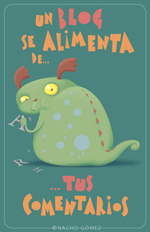Hay hombres cuyas palabras son como golpes de espada; mas la lengua de los sabios es medicina.
Proverbios 12:18
Los libros contienen palabras. Hay entonces libros que hieren mientras que otros alivian. Hay libros que inspiran y hay otros que adormecen. Hay libros de virtud, pero también existen otros de los que se dice han sido susurrados al oído humano por demonios.
Hay libros que nos sirven como freno...
¡Oh Kempis, Kempis, asceta yermo,
pálido asceta, qué mal me hiciste!
¡Ha muchos años que estoy enfermo,
y es por el libro que tú escribiste!
Amado Nervo
Hay otros que envenenan...
The hero of the wonderful novel that had so influenced his life had himself known this curious fancy. In the seventh chapter he tells how, crowned with laurel, lest lightning might strike him, he had sat, as Tiberius, in a garden at Capri, reading the shameful books of Elephantis, while dwarfs and peacocks strutted round him and the flute-player mocked the swinger of the censer; and, as Caligula, had caroused with the green-shirted jockeys in their stables and supped in an ivory manger with a jewel- frontleted horse; and, as Domitian, had wandered through a corridor lined with marble mirrors, looking round with haggard eyes for the reflection of the dagger that was to end his days, and sick with that ennui, that terrible taedium vitae, that comes on those to whom life denies nothing; and had peered through a clear emerald at the red shambles of the circus and then, in a litter of pearl and purple drawn by silver-shod mules, been carried through the Street of Pomegranates to a House of Gold and heard men cry on Nero Caesar as he passed by; and, as Elagabalus, had painted his face with colours, and plied the distaff among the women, and brought the Moon from Carthage and given her in mystic marriage to the Sun.
Over and over again Dorian used to read this fantastic chapter, and the two chapters immediately following, in which, as in some curious tapestries or cunningly wrought enamels, were pictured the awful and beautiful forms of those whom vice and blood and weariness had made monstrous or mad: Filippo, Duke of Milan, who slew his wife and painted her lips with a scarlet poison that her lover might suck death from the dead thing he fondled; Pietro Barbi, the Venetian, known as Paul the Second, who sought in his vanity to assume the title of Formosus, and whose tiara, valued at two hundred thousand florins, was bought at the price of a terrible sin; Gian Maria Visconti, who used hounds to chase living men and whose murdered body was covered with roses by a harlot who had loved him; the Borgia on his white horse, with Fratricide riding beside him and his mantle stained with the blood of Perotto; Pietro Riario, the young Cardinal Archbishop of Florence, child and minion of Sixtus IV, whose beauty was equalled only by his debauchery, and who received Leonora of Aragon in a pavilion of white and crimson silk, filled with nymphs and centaurs, and gilded a boy that he might serve at the feast as Ganymede or Hylas; Ezzelin, whose melancholy could be cured only by the spectacle of death, and who had a passion for red blood, as other men have for red wine -- the son of the Fiend, as was reported, and one who had cheated his father at dice when gambling with him for his own soul; Giambattista Cibo, who in mockery took the name of Innocent and into whose torpid veins the blood of three lads was infused by a Jewish doctor; Sigismondo Malatesta, the lover of Isotta and the lord of Rimini, whose effigy was burned at Rome as the enemy of God and man, who strangled Polyssena with a napkin, and gave poison to Ginevra d'Este in a cup of emerald, and in honour of a shameful passion built a pagan church for Christian worship; Charles VI, who had so wildly adored his brother's wife that a leper had warned him of the insanity that was coming on him, and who, when his brain had sickened and grown strange, could only be soothed by Saracen cards painted with the images of love and death and madness; and, in his trimmed jerkin and jewelled cap and acanthuslike curls, Grifonetto Baglioni, who slew Astorre with his bride, and Simonetto with his page, and whose comeliness was such that, as he lay dying in the yellow piazza of Perugia, those who had hated him could not choose but weep, and Atalanta, who had cursed him, blessed him.
There was a horrible fascination in them all. He saw them at night, and they troubled his imagination in the day. The Renaissance knew of strange manners of poisoning -- poisoning by a helmet and a lighted torch, by an embroidered glove and a jewelled fan, by a gilded pomander and by an amber chain. Dorian Gray had been poisoned by a book. There were moments when he looked on evil simply as a mode through which he could realize his conception of the beautiful.
The Picture of Dorian Gray
Chapter XI (a fragment)
Oscar Wilde





























































































2 comentarios:
Vengo a devolverte tu visita a mi planeta. Me agrada que te haya gustado mi blog. A mi también me ha gustado el tuyo.
Y sí, hay libros que envenenan...
Saludos!
Gracias por la visita, Sonia.
Publicar un comentario